#Kunisada Utagawa Art
Explore tagged Tumblr posts
Text

THE STRIKING ARTISTRY OF THE KABUKI ACTOR'S PORTRAIT -- THE WIZARDRY OF THE TRADITIONAL WOODBLOCK PRINT.
PIC INFO: Spotlight on a woodblock print by illustrator Utagawa Kunisada I (Toyokuni III) of the Kabuki theater actor Ichikawa Ebizō V., playing the role of Usui Sadamitsu, the piece was reportedly published c. September 1863.
EXTRA INFO: "Featuring 200 prints by 89 artists, Taschen’s book "Japanese Woodblock Prints (1680-1983)" is a journey through two centuries of the art form. Ranging from depictions of everyday life to kabuki and erotica, the XXL edition is a 622-page art history lesson and a high-resolution visual compendium rolled into one."
-- TASCHEN BOOKS (luxury artbooks publisher)
Source: www.itsnicethat.com/articles/japanese-woodblock-prints-taschen-publication-021219 & Wikimedia.
#Japanese Woodblock Print#Japanese Art#Utagawa Kunisada#Kunisada Utagawa#1863#1860s#Kabuki Theatre#Japanese Woodblock#Japanese Culture#Utagawa Kunisada Artist#Japanese Woodblock Prints#Ichikawa Ebizō V#Usui Sadamitsu#Kunisada Utagawa Artist#Kabuki Theater Makeup#Kabuki#Kabuki Art#Kabuki Theater Art Prints#Kabuki Art Prints#Taschen#Taschen Books#Historical Fashion#Kunisada Utagawa Art#Kabuki Theater Actor#Japanese#Kabuki Actor#Kabuki Culture#Japan#Woodblock#Woodblock Art
4 notes
·
View notes
Text

Utagawa Kunisada - A Crab on the Seashore, 19th c, Japan.
224 notes
·
View notes
Text
More for #ILoveHorsesDay ❤️🐴:


Horses, a New Publication (Shimpan uma zukushi)
Color woodblock prints
c.1847-8 by Utagawa Hiroshige II (Japan, 1826–1869), 377x257mm
1874 by Utagawa Kunisada III (Japan, 1848–1920), 337x225mm
Legion of Honor Museum 1963.30.1472, 1963.30.5519
#animals in art#animal holiday#19th century art#Legion of Honor Museum#Japanese art#East Asian art#Asian art#horse#horses#I Love Horses Day#domesticated animals#print#woodblock print#Utagawa Hiroshige II#Utagawa Kunisada II#ukiyoe
75 notes
·
View notes
Text

Crowley and Kinoshin-zeki dine at Ritsu. Well, one dines and one watches.
This is based on "The Wrestlers Of Sumo Kuroiwa And Zogahana With A Geisha" by Utagawa Kunisada (C 1845). I saw it and I was like "well I guess I'm making another one."


Making heart eyes at one another.
#good omens#goodomens#Good SumOmens#sumo#utagawa kunisada#this is again mostly a trace#lickthecowhappy's art#that tartan sash was nearly the end of me#グッドオーメンズ#グッドスモーメンズ#ukiyo-e style#ukiyo-e#ukiyo e#ukiyoe
34 notes
·
View notes
Text

The Akashi Bathhouse, Utagawa Kunisada, 1850
#utagawa kunisada#ukiyo-e#edo period#i would have close ups but the austrian museum of applied arts puts huge watermarks on their scans -___-#six page spread
22 notes
·
View notes
Text
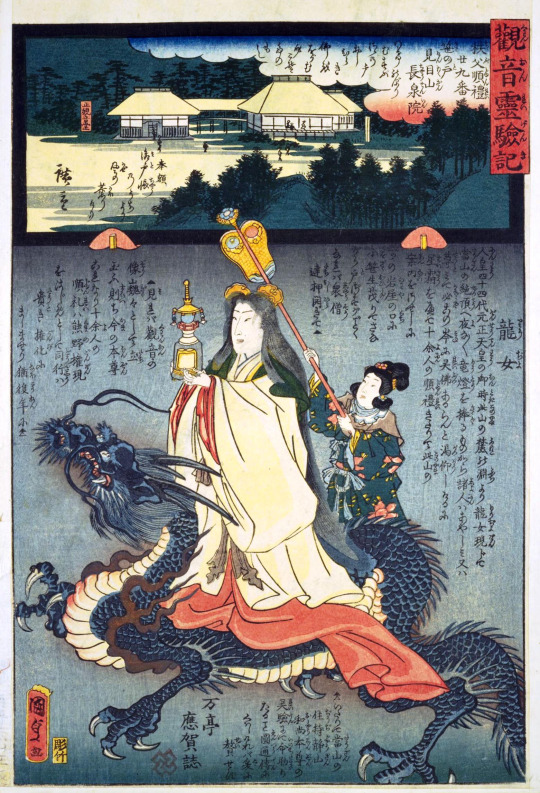
Dragon Woman during the Time of Empress Gensho, Kunisada, 1800
#art#art history#Asian art#Japan#Japanese art#East Asia#East Asian art#ukiyo-e#woodblock print#Kunisada#Utagawa Kunisada#Utagawa School#Edo period#18th century art
256 notes
·
View notes
Photo

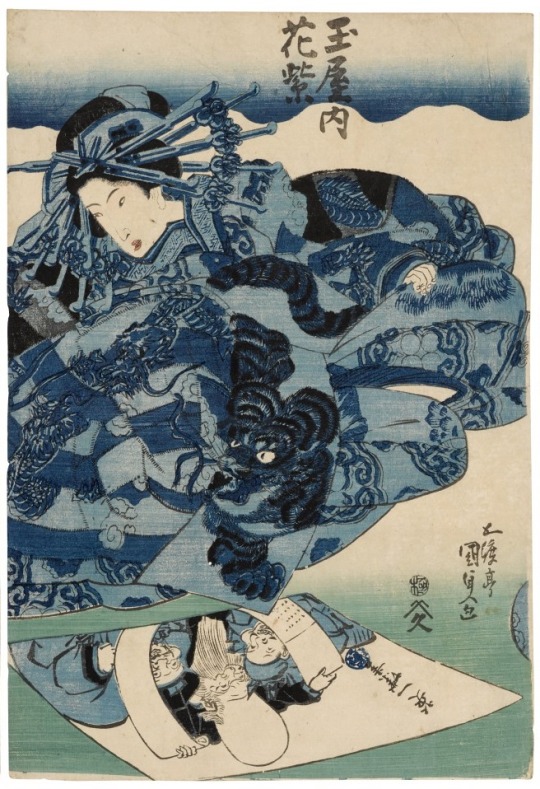
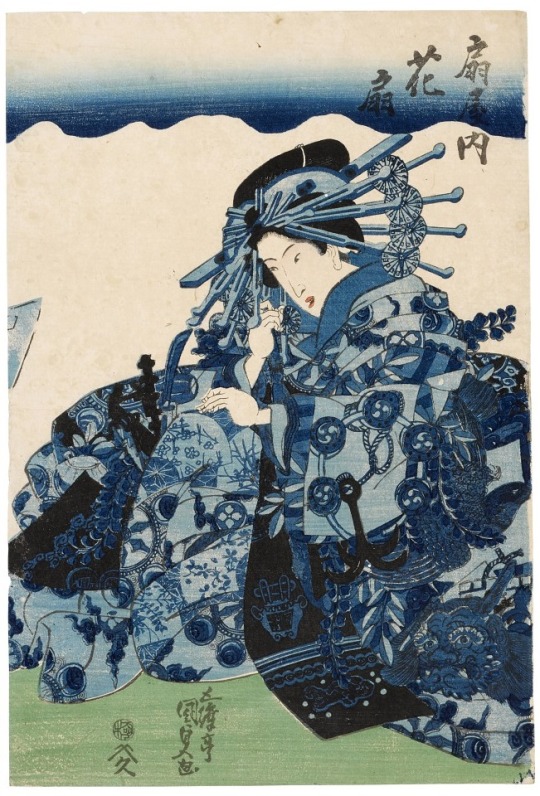
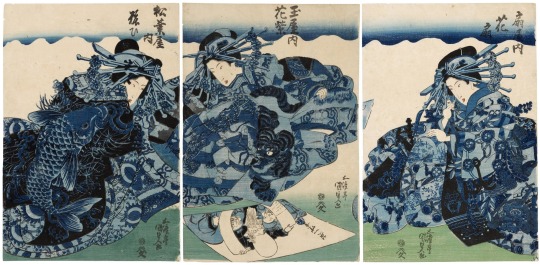
Utagawa Kunisada
Ogiya uchi Hanaogi, Tamaya uchi Hanamurasaki, Matsubaya uchi Yosoi (The courtesans Hanaogi from the Ogiya house, Hanamurasaki from the Tamaya house and Yosoi from the Matsubaya house). ca. 1830
#utagawa kunisada#art print#woodblock art#triptych#edo period#blue art#ukiyo-e#japanese beauties#traditional japanese art#aizuri#private collection
210 notes
·
View notes
Photo

Poet and butterfly, published by Otaya Takichi by Utagawa Kunisada (colour woodblock print)
#art#artwork#kunst#kunstwerk#utagawa kunisada#artist#künstler#otaya takichi#person#human being#mensch#poet#dichter#poetry#writing#schreiben#animals#tiere#insects#insekten#butterflies#schmetterlinge#asian art#asiatische kunst#colors#farben#woodblock print#art prints#kunstdrucke
24 notes
·
View notes
Text
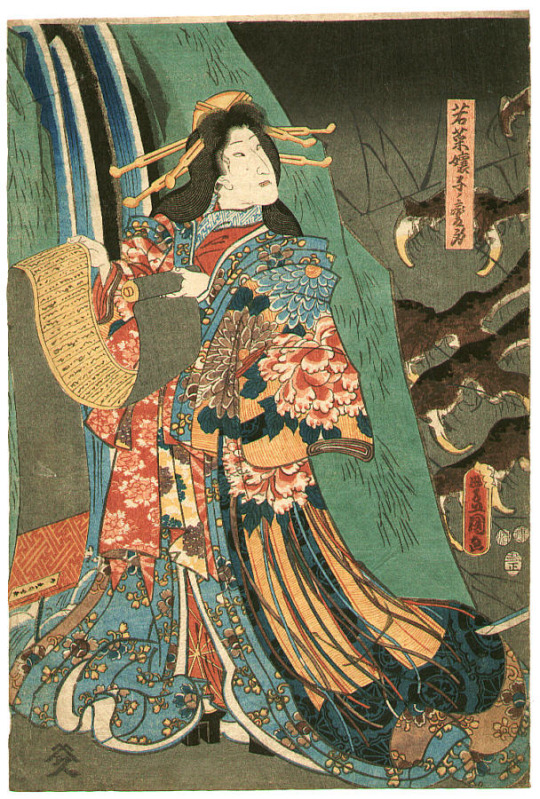
Utagawa Kunisada
Spider Woman
1853
#utagawa kunisada#japanese prints#japanese artist#japanese art#woodcut#woodblock print#asian art#spider art#spider#art history#aesthetictumblr#tumblraesthetic#tumblrpic#tumblrpictures#tumblr art#aesthetic#beauty#tumblrstyle
24 notes
·
View notes
Text
Utagawa Kunisada - Toyokuni III
1786-1865
Morita Kanya XI in the role of Saito Tarozaemon Toshiyuki.
1860
woodblock print
14 3/8 by 10 in.
36.5 by 25.3 cm.

Scholten Japanese Art presents “Strike a Pose: Spectacular Imagery of the Kabuki Theater,” an exhibition that brings together an array of imagery related to one of Japan’s most distinctive, and yet possibly least understood, cultural exports: the kabuki theater. The exhibition focuses on ukiyo-e woodblock prints portraying popular actors in lavish costumes on stage as well as relaxing off stage. On view September 8–16, and then again November 1–5 for Print Week, at 145 West 58th Street, Suite 6D.
#utagawa kunisada#artist painter#Utagawa Kunisada - Toyokuni III#japanese artist painter#original art#Morita Kanya XI in the role of Saito Tarozaemon Toshiyuki#woodblock print#art#Toyokuni III#beisaku#huyiro raiko#sai aeko#xpuigc
14 notes
·
View notes
Text
Paysanne et enfant à Kakegawa, 26è station du Tokaido (Musée Guimet / MNAAG, Paris)

Kakegawa, 26è station ; au premier plan, une paysanne portant une bouilloire et un chapeau de paille dans le dos avec un jeune garçon
Sur la gauche, après le pont, on observe la présence d'un Tori-i ce qui indique la présence d'un sanctuaire. Au fond, au loin, le mont Akiba
Le Tokaido est la plus importante des 5 routes du Japon à l'époque d'Edo, elle relie Edo (Tokyo), lieu du pouvoir du Shogun à Kyoto, lieu de résidence de l'Empereur.
26è relais ou station : Kakegawa
(série : cinquante-trois stations du Tokaido)
Utagawa Hiroshige 1 (1797-1858)
Utagawa Kunisada (Toyokuni III) (1786-1865)
Époque d'Edo (1603-1868)
1854-1857
Éditeur : Maruya Kyushiro
Estampe japonaise polychrome (nishiki-e)
Collection Leskowicz, Paris
#Kakegawa#japan#fashion#japanese#kimono#Tori-i#art#ukiyoe#Tokaido#akiba#edo period#tokyo#shogun#Utagawa Kunisada#Utagawa Hiroshige#Toyokuni III#1850s#nishiki-e#woodblock
7 notes
·
View notes
Text
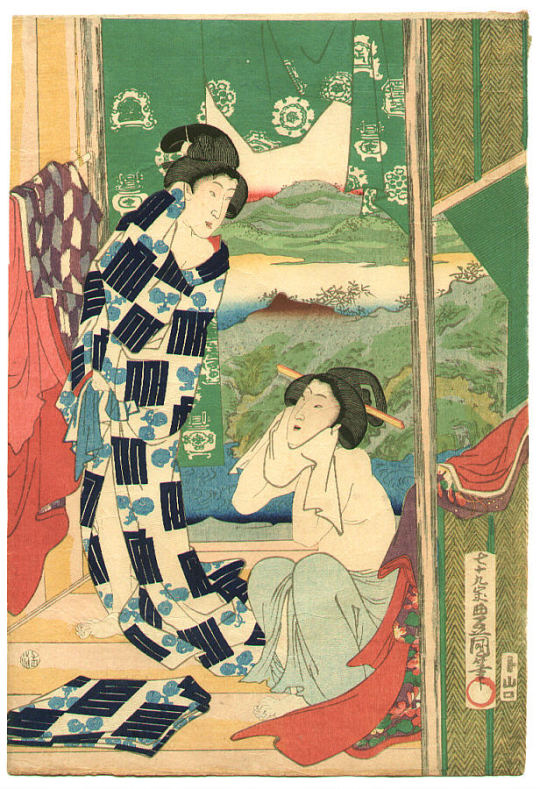
After Bathing Beauties - Genji
Utagawa Kunisada - 1864
"Furyu Gogyo no Uchi; Suisei"
The refreshing waterfall in the summer and prince Genji.
#art#japan#japan art#waterfall#utagawa kunisada#japanese culture#japanese art#ukiyoe#woodblock#woodblock print#ukiyo e#asian art
13 notes
·
View notes
Text

Kiso Yoshinaka and the Flight of the Child Emperor
Tomoe Gozen, by Kitao Masayoshi, Edo Period, Source: Ukiyo-e.org
The Rise of the Minamoto: Japan’s First Shogunate
The samurai, through most of Japan’s history, were the ruling warrior class. But that wasn’t always so. Discover how Japan transitioned under the Minamoto.
Yoshitsune’s Campaign

The Battle of Ichi-no-Tani, on folding screen, late 1600s, Source: Wikimedia Commons
Dan-no-Ura

Yoshitsune Leaps Over Eight Boats, by Utagawa Yoshitoshi, 19th century, Source: The Art of Japan
The Kamakura Shogunate

Hunting at the Foot of Mount Fuji, by Utagawa Kunisada, 1820, Source: Japanese Prints
#the rise of the minamoto#japan#history#minamoto#shogunate#samarai#kitao masayoshi#artist#art#utagawa yoshitoshi#utagawa kunisada
2 notes
·
View notes
Text
#FrogFriday 🐸:

Utagawa Kunisada 歌川国貞 (Toyokuni III) (Japan, 1786-1864)
Portrait of kabuki actor Sawamura Sojuro V as Nippon Daemon, 1864
Series: Toyokuni kigo kijutsu kurabe (Contest of Toyokuni Brushwork Wizardry)
Color woodblock print, H38.80 x W26.70 cm
British Museum 2018,3021.207
image © The Trustees of the British Museum (CC BY-NC-SA 4.0)
#animals in art#animal holiday#19th century art#print#woodblock print#frog#frogs#Frog Friday#ukiyoe#Japanese art#Asian art#East Asian art#kabuki#British Museum#Utagawa Kunisada#Sawamura Sojuro V#Nippon Daemon
21 notes
·
View notes
Photo

“Erotic Ukiyoe” by Kunisada Utagawa
(via A Bedside Guide to the Colours of Love in Spring and Other Erotic Prints by Kunisada (NSFW) - Flashbak)
19 notes
·
View notes
Photo
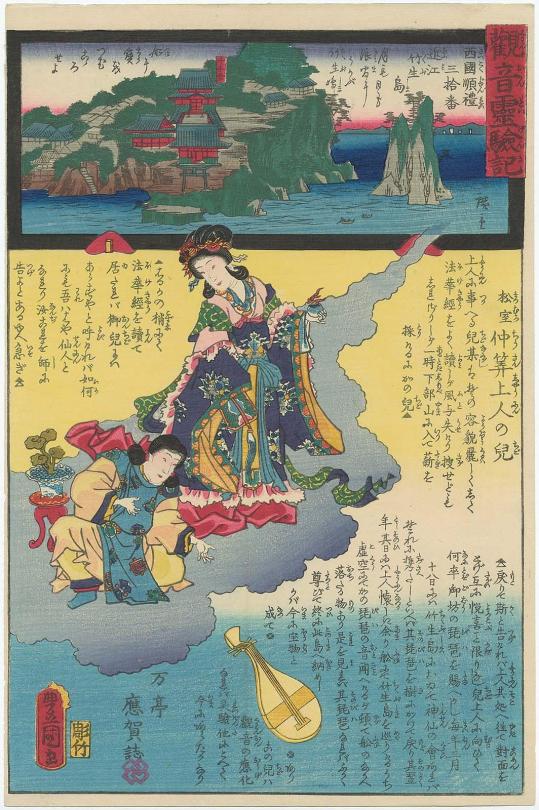
“Chikubushima in Ōmi Province, No. 30 of the Saikoku Pilgrimage Route” from the series “The Miracles of Kannon” (観音霊験記 Kannon Reigenki) by Utagawa Kunisada I (歌川国貞), 1859: depicting the layout of Hōgonji Temple (宝厳寺) on Chikubushima Island in present-day Nagahama, Shiga Prefecture above, below a scene from the tale wherein a monk’s transcendent acolyte gifts him a sacred biwa to be presented to the temple
Color woodblock print, ōban from the collection of the Museum of Fine Arts, Boston
#japanese art#japanese prints#歌川国貞#utagawa kunisada#近江国#omi no kuni#滋賀県#shiga prefecture#長浜市#nagahama#竹生島#chikubushima#chikubu island#宝厳寺#hogonji#真言宗#shingon#西国三十三所
23 notes
·
View notes